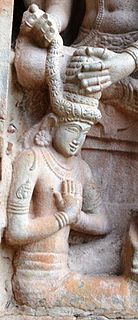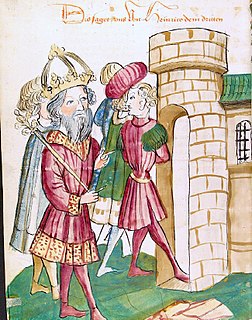
Year 1017 (MXVII) was a common year starting on Tuesday of the Julian calendar.
The 1010s was a decade of the Julian Calendar which began on January 1, 1010, and ended on December 31, 1019.

The Battle of Civitate was fought on 18 June 1053 in southern Italy, between the Normans, led by the Count of Apulia Humphrey of Hauteville, and a Swabian-Italian-Lombard army, organised by Pope Leo IX and led on the battlefield by Gerard, Duke of Lorraine, and Rudolf, Prince of Benevento. The Norman victory over the allied papal army marked the climax of a conflict between the Norman mercenaries who came to southern Italy in the eleventh century, the de Hauteville family, and the local Lombard princes. By 1059 the Normans would create an alliance with the papacy, which included a formal recognition by Pope Nicholas II of the Norman conquest in south Italy, investing Robert Guiscard as Duke of Apulia and Calabria, and Count of Sicily.

The Catepanateof Italy was a province of the Byzantine Empire, comprising mainland Italy south of a line drawn from Monte Gargano to the Gulf of Salerno. Amalfi and Naples, although north of that line, maintained allegiance to Constantinople through the catepan. The Italian region of Capitanata derives its name from the Catepanate.
Humphrey of Hauteville, surnamed Abagelard, was the Count of Apulia and Calabria from 1051 to his death.
Argyrus was a Lombard nobleman and Byzantine general, son of the Lombard hero Melus. He was born in Bari.

Pandulf IV was the Prince of Capua on three separate occasions.
Melus was a Lombard nobleman from the Apulian town of Bari, whose ambition to carve for himself an autonomous territory from the Byzantine catapanate of Italy in the early eleventh century inadvertently sparked the Norman presence in Southern Italy.

Basil Boioannes, called Bugiano in Italian, was the Byzantine catapan of Italy and one of the greatest Byzantine generals of his time. His accomplishments enabled the Empire to reestablish itself as a major force in southern Italy after centuries of decline. Yet, the Norman adventurers introduced into the power structure of the Mezzogiorno would be the eventual beneficiaries.
Basil Mesardonites was the Catapan of Italy, representing the Byzantine Emperor there, from 1010 to 1016 or 1017. He succeeded the catapan John Kourkouas, who died fighting the Lombards, then in rebellion under Melus, early in 1010. In March, Basil disembarked with reinforcements from Constantinople and Leo Tornikios Kontoleon, the strategos of Cephalonia. Basil immediately besieged the rebels in Bari. The Greek citizens of the city negotiated with Basil and forced the Lombard leaders, Melus and Dattus, to flee. Basil entered the city on June 11, 1011 and reestablished Byzantine authority. He did not follow his victory up with any severe reactions. He simply sent the family of Melus, including his son Argyrus, to Constantinople. Basil's next move was to ally to the Roman Empire as many Lombard principalities as possible. He visited Salerno in October, where Prince Guaimar III was nominally a Byzantine vassal. He then moved on to Monte Cassino, which monastery was sheltering Dattus on its lands. Basil nevertheless confirmed all the privileges of the monastery over its property in Greek territory. The abbot, Atenulf, was a brother of the prince of Capua, Pandulf IV. The monastery then promptly expelled Dattus and he fled to papal territory. Basil held the Greek catapanate in peace until his death in 1016, or, according to Lupus Protospatharius, 1017. He was replaced by the aforementioned strategos of Cephalonia, Leo.
Leo Passianos was the Byzantine general sent by the Catapan of Italy Leo Tornikios Kontoleon to fight the Lombard rebel Melus of Bari in 1017. He is not to be confused with the other Passianos killed in Melus' first rebellion while fighting the Saracens under Ishmael of Montepeloso.
Rudolph Drengot was one of the Drengot family of Norman adventureres who came to Southern Italy with his brothers, Gilbert, Asclettin, Osmond, and Ranulf.
The Drengots were a Norman family of mercenaries, one of the first to head to the Mezzogiorno of Italy to fight in the service of the Lombards. They became the most prominent family after the Hautevilles.
John Kourkouas was the Byzantine catepan of Italy from 1008 to his death. Belonging to the Kourkouas family, he was of Armenian descent.
Dattus was a Lombard leader from Bari, the brother-in-law of Melus of Bari. He joined his brother-in-law in a 1009 revolt against Byzantine authority in southern Italy.
Miriarcha is the name given in the Chronicon breve normannicum to the Byzantine general who led the defence of the Catapanate of Italy in 1060–1062. The anonymous chronicler has, however, misinterpreted the Greek title merarches as a name. The actual name of the general is unknown, and since the rank of merarches is not otherwise clearly attested in southern Italy his exact function is not known either. Probably the office was immediately below that of the catapan.

The Norman conquest of southern Italy, also known as The Kingdom In The Sun, lasted from 999 to 1139, involving many battles and independent conquerors.
Nikephoros Phokas, usually surnamed the Elder to distinguish him from his grandson, Emperor Nikephoros II Phokas, was one of the most prominent Byzantine generals of the late 9th century, and the first important member of the Phokas family. As a youth he was taken into the personal retinue of Emperor Basil I the Macedonian, rising quickly to the posts of protostrator and then governor of Charsianon, whence he fought with success against the Arabs. In c. 886 he led a major expedition in southern Italy, where his victories laid the foundation for the Byzantine resurgence in the peninsula. After his return, he was raised to the post of Domestic of the Schools, in effect commander-in-chief of the army, which he led with success against the Arabs in the east and the Bulgarians of Tsar Simeon in the Balkans. He died either in 895/6 or, less likely, sometime c. 900. Contemporaries and later historians lauded him for his military ability and character. Both of his sons later succeeded him as Domestics of the Schools. His grandsons Nikephoros and Leo were likewise distinguished generals, while the former became emperor in 963–969, spearheading the recovery of several lost provinces from the Arabs.
Abulchares was a Byzantine general of Arab origin who served as the catepan of Italy from 1064 until his death. The chief sources for his catapanate are Skylitzes Continuatus and Anonymi Barensis Chronicon. Skylitzes Continuatus records that Abulchares was also duke (doux) of Dyrrhachium across the Adriatic, but this is chronologically impossible, since Perenos is recorded as duke at this time.
Joscelin was a Norman count of Molfetta on the Adriatic coast of southern Italy. He rejected the leadership of Duke Robert Guiscard and rebelled, perhaps as early as 1064, certainly by 1067. Defeated, he went over the Byzantines in 1068.





